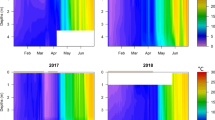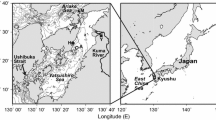Abstract
The factors influencing the seasonal dynamics of Daphnia in a thermally stratified lake (Esthwaite Water) are described and related to long-term changes in the weather. The Daphnia produced three cohorts in the year and the strength of the cohorts was determined by year-to-year variations in the physical characteristics of the lake and the abundance of edible algae. Food was most abundant in early summer when small, fast-growing flagellates were particularly common. In late summer, the phytoplankton community was dominated by large, inedible species but edible forms re-appeared when nutrients were entrained by wind mixing. Examples are presented to demonstrate the effect that year-to-year variations in the weather have on the growth of the phytoplankton and the dynamics of the Daphnia. In ‘good’ years, when the lake stratifies early and there are periods of episodic mixing in summer, there are two ‘pulses’ of edible algae and two strong cohorts of Daphnia. In ‘bad’ years when stratification is delayed and there is little episodic mixing, the growth of the edible algae is suppressed and the Daphnia produce two weak cohorts. The results are discussed in relation to the impact of intermediate disturbances on growth of phytoplankton and current theories of population regulation in Daphnia. The evidence suggests that the dynamics of the Daphnia in the lake are strongly influenced by seasonal variations in the mixing regime, the recycling of nutrients and the episodic growth of edible algae.
Similar content being viewed by others
References
Adrian R. 1997. Calanoid–cyclopoid interactions: evidence from an 11-year field study in a eutrophic lake. freshwater Biol. 38: 315–325
Allen CM, Simpson JH and Carson RM (1980) The structure and variability of shelf sea fronts as observed by an undulating CTD system. Oceanol Acta 3:59–68
Benndorf J, Cranich J, Mehner T and Wagner A (2001) Temperature impact on the midsummer decline of Daphnia galeata: an analysis of long-term data from the biomanipulated Bautzen Reservoir (Germany). Freshwat Biol 46:199–211
Benndorf J, Böing W, Koop J and Neubauer I (2002) Top-down control of phytoplankton: the role of time-scale, lake depth and trophic state. Freshwat Biol 47:2282–2295
Chorus I and Schlag G (1993) Importance of intermediate disturbances for the species composition and diversity of phytoplankton in two very different Berlin lakes. Hydrobiologia 249:67–92
Connell J (1978) Diversity in tropical rain forests and coral reefs. Science 199:1304–1310
DeMott W.R. 1989. The role of competition in zooplankton seasonal succession. In: Sommer U. (ed.), Succession in Plankton Communities, Springer, Berlin pp. 195–252
Ferguson AJD, Thompson JM and Reynolds CS (1982) Structure and dynamics of zooplankton communities maintained in closed systems, with special reference to the algal food supply. J Plankton Res 4: 523–543
Gaedke A and Sommer U (1986) The influence of the frequency of periodic disturbances on the maintenance of phytoplankton diversity. Oecologia 71: 98–102
George DG (2000) The impact of regional-scale changes in the weather on the long-term dynamics of Eudiaptomus and Daphnia in Esthwaite Water, Cumbria. Freshwat Biol 43: 111–121
George DG and Heaney SI (1978) Factors influencing the spatial distribution of phytoplankton in a small productive lake. J Ecol 66: 133–155
George DG and Allen CM (1994) Turbulent mixing in a small, thermally stratified lake. In: Beven K, Chatwin P and Millbank J (eds). Mixing and Transport in the Environment. Wiley, Chichester, pp. 1—15
George DG and Taylor AH (1995) UK lake plankton and the Gulf Stream. Nature 378: 139
George DG, Hewitt DP, Lund JWG and Smyly W (1990) The relative effects of enrichment and climatic change on the long-term dynamics of Daphnia in Esthwaite Water, Cumbria. Freshwat Biol 23: 55–70
George DG, Hewitt DP (1998) The influence of latitudinal movements of the Atlantic Gulf Stream on the biomass of zooplankton in the north-basin of Windermere. In: George DG, Sutcliffe DW, Reynolds CS, Jones JWG, Puncochar P (eds) Managing lakes under conditions of Global Change. NATO ASI Series Kluwer, Dordrecht, pp. 223–244
George D.G. and Hewitt D.P. (1995) The influence of year-to-ear variations in winter weather on the dynamics of Daphnia and Eudiaptomus in Esthwaite water, Cumbria. Funct. Ecol. 13: 45–54
George DG and Reynolds CS. (1997) Zooplankton-phytoplankton interactions: the case for refining methods, measurements and models. Aquat Ecol 31: 59–71
Harris GP (1986) Phytoplankton Ecology: Structure, Function and Fluctuation. Chapman and Hall, London
Heaney SI, Smyly WJP and Talling F (1986) Interactions of physical, chemical and biological processes in depth and time within a productive English lake during summer stratification. Int Rev Ges Hydrobiol 17: 441–494
Hulme M, Jenkins GJ, Lu X, Turnpenny JR, Mitchell TD, Jones RG, Lowe J, Murphy JM, Hassell D, Boorman P, McDonald R, Hill S (2002) Climate Change Scenarios for the United Kingdom: The UKCIP02 Scientific Report, Tyndall Centre for Climate Change Research, School of Environmental Sciences. University of East Anglia, Norwich, UK
Lampert W, Muck P (1985) Multiple aspects of food limitation in zooplankton communities: the Daphnia - Eudiaptomus example. Arch Hydrobiol Beiheft 21: 311–322
Lund JWG, Talling JF (1957) Botanical limnological methods with special reference to the algae. Bot Rev 23: 489–583
Lund JWG, Kipling C, Le Cren ED (1958) The inverted microscope method of estimating algal numbers and the statistical basis of estimations by counting. Hydrobiologia 11: 143–170
Lund J.W.G. 1972. Changes in the biomass of blue-green and other algae in an English lake from 1945–69. In: Desikachary T.V. (ed.), Taxonomy and Biology of Blue-green Algae, pp. 305–327, Madras Symposium, 1970
Mackereth FJH (1964) An improved galvanic cell for the determination of oxygen in fluids. J Sci Instrument 41: 38–41
McCauley E, Murdoch WW (1987) Cyclic and stable populations: plankton as paradigm. Amer Nat 129: 97–121
Mortimer CH (1941) The exchange of dissolved substances between mud and water in lakes. J. Ecol 29: 280–329
Murdoch WW, McCauley E (1985) Three distinct types of dynamic behaviour shown by single planktonic system. Nature 316: 628–630
Padisak J (1993) The influence of different disturbance frequencies on the species richness, diversity and equitability of phytoplankton in shallow lakes. Hydrobiologia 249: 135–156
Reynolds CS (1984) The Ecology of Freshwater Phytoplankton. Cambridge University Press, Cambridge
Reynolds CS (1988) Functional morphology and the adaptive strategies of freshwater phytoplankton. In: Sandgren CD (eds) Growth and Reproductive Strategies of Freshwater Phytoplankton. Cambridge University Press, New York, pp. 388–433
Reynolds CS (1993) Scales of disturbance and their role in plankton ecology. Hydrobiologia 249: 157–171
Reynolds CS (1994) The ecological basis for the successful biomanipulation of aquatic communities. Arch Hydrobiol 130: 1–33
Reynolds CS (1997) Vegetation Processes in the Pelagic: A Model for Ecosystem Theory. Ecology Institute, Oldendorf, Germany, pp. 371
Romme WH, Everham EH, Frelich LE, Moritz MA, Sparks RE (1998) Are large, infrequent disturbances qualitatively different from small frequent disturbances?. Ecosystems 1: 524–534
Rothhaupt KO (1990) Resource competition of herbivorous zooplankton: a review of approaches and perspectives. Arch Hydrobiol Beiheft 118: 1–29
Round FE (1971) The growth and succession of algal populations in freshwaters. Mitt Int Ver Limnol 19: 70–99
Scourfield D.J. and Harding J.P. 1966. A Key to the British Freshwater Cladocera. Freshwater Biological Association, Scientific Publication No. 1, 3rd ed.
Statgraphics Plus (1997) User Manual (Version 3). Manugistics Inc., Maryland USA
Sommer U, Gliwicz M, Lampert W, Duncan A (1986) The PEG-model of seasonal succession of planktonic events in fresh water. Arch Hydrobiol 106: 433–471
Straile D, Geller W (1998) The response of Daphnia to changes in trophic status and weather patterns, a case study from Lake Constance. ICES J Mar Science 55: 775–782
Talling JF, Heaney SI (1988) Long-term changes in some English (Cumbrian) lakes subjected to increased nutrient inputs. In: Round FE (eds) Algae and the Aquatic Environment. Biopress, Bristol, pp. 1—29
Trimbee AM, Harris GP (1983) Use of time-series analysis to demonstrate advection rates of different variables in a small lake. J Plankton Res 5: 819–833
Acknowledgements
We would like to thank W.J.P. Smyly for organizing the sampling programme and Mr T. Furnass for counting the zooplankton samples. The phytoplankton counts are taken from an earlier publication prepared in collaboration with Dr J.W.G. Lund. This study was part funded by the European Union Environment and Climate projects REFLECT (ENV4-CT97-0453) and CLIME (EVK-CT-2002-00121).
Author information
Authors and Affiliations
Corresponding author
Rights and permissions
About this article
Cite this article
George, D.G., Hewitt, D.P. The impact of year-to-year changes in the weather on the dynamics of Daphnia in a thermally stratified lake. Aquat Ecol 40, 33–47 (2006). https://doi.org/10.1007/s10452-005-9013-3
Received:
Accepted:
Published:
Issue Date:
DOI: https://doi.org/10.1007/s10452-005-9013-3




